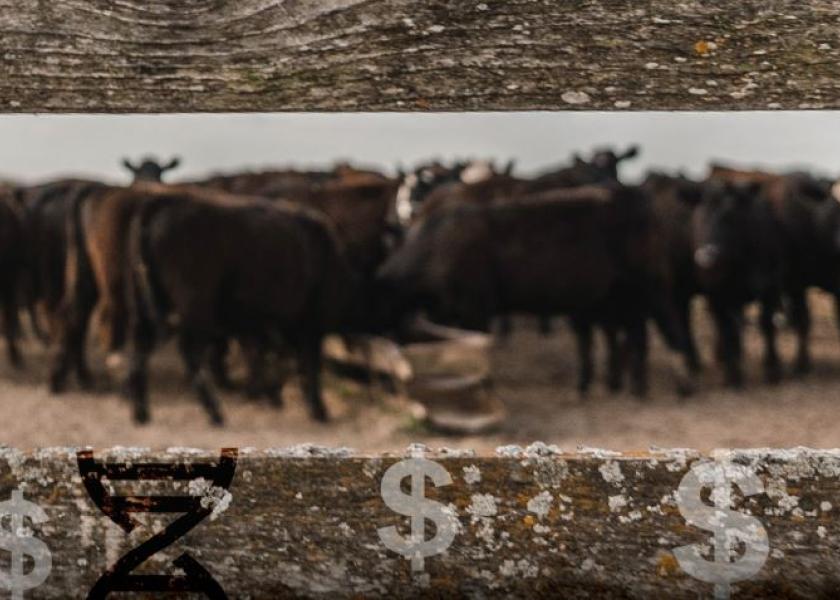Genetic Merit Pricing: Revolutionizing Feeder Cattle Value

Relief has come to some, but many ranchers throughout a large swath of the Central Plains continue to struggle with lingering drought. Now, with winter looming, many face tough decisions about the path forward. The direction they choose could represent a critical juncture for the future of the U.S. beef industry.
“We expected the industry would be considering expansion by now,” says Derrell Peel, Oklahoma State University Extension economist. “Persistent drought has made it difficult to stop herd liquidation, never mind stabilizing and then rebuilding the herd.”
Through early October, 40% of the U.S. was in some stage of drought with 23% in severe to exceptional drought. Peel says the continued liquidation of cows and heifers means the industry has little ability for expansion anytime soon.
“The latest monthly slaughter data shows that total female (cow and heifer) slaughter has averaged 51.7% of total cattle slaughter over the last year, the highest average rate since 1986,” Peel says.
Opportunity
Despite the hardship that drought has brought to cow country, ranchers remain resilient. Drovers’ State of the Beef Industry producer survey conducted earlier this year found that just 13% considered exiting the business due to the drought. Conversely, 66% said hanging up their spurs was never an option.
Certainly, the prospect of higher cattle prices is an incentive for many, and the prospects of rebuilding their herd could offer new opportunities. Most industry observers agree that the U.S. cowherd is generally of higher quality than it was at the end of the previous liquidation phase a decade ago. Today’s smaller herd presents an opportunity for ranchers to take another step forward with quality and management.
Such progress won’t be easy as the low-hanging fruit has already been picked. University Extension specialists generally agree refining production efficiency and resource utilization remains a challenge. Improving carcass quality or postweaning performance could increase ranch income through increased weaned calf value and/or postweaning performance and carcass value. But constant selection for growth and carcass can lead to increased annual cow costs.
In a 2019 research paper, “Matching Beef Cows to Forage Resources,” Oklahoma State University beef specialist David Lalman, et al, observed: “profit-minded commercial cow-calf enterprises need to a) maintain good records b) shift focus to controlling cowherd input costs, and c) work to capture increased postweaning value through marketing or some form of retained ownership.”
Pricing Task Force
Controlling costs might be di¬fficult, but capturing more value for calves could offer significant opportunities. That’s the idea behind the Genetic Merit Pricing Task Force, a coalition of 32 producers and industry stakeholders dedicated to helping the industry accelerate toward widespread use of genetic information in pricing feeder cattle. Ken Odde, former Kansas State University animal science department head and group facilitator, believes the Genetic Merit Pricing Task Force has a critical mission that can help make all industry segments more efficient and prosperous. (The group’s initial meeting was held Nov. 2 in Denver.)
“If you look at crops, pork, poultry, dairy and virtually all other agricultural products, genetics are heavily emphasized,” Odde says. “Yet in the beef industry, we trade millions of feeder cattle and calves annually, while knowing next to nothing about their genetics. Without objective genetic information on potential growth rate, feed e¬fficiency, marbling and other key traits, we cannot accurately project how a given group of cattle will perform or how valuable their carcasses will be. That lack of genetic information creates a big hole in our ability to price cattle according to their true value.”
More Than Calf Health
Over the past 20 years, Odde says when considering value-added calves the industry mostly thinks of calf health. “Now, I think we are in transition,” he says. “I believe the next 20 years the major progress is going to come on the genetic side.”
That means more commercial cow-calf operators will need to capture and record data about genetics and performance, but that is just the beginning.
“They must also have a marketing plan,” recommends Craig Uden, former NCBA president and co-owner of Darr Feedlot in Cozad, Neb. “Producers must learn to get their cattle in front of the right audience of buyers.”
Weaning, vaccinating and pre-conditioning calves with the auctioneer’s mention on sale day stops short of the goal line. Producers must market their calves.
“My most astute feeding custom ers want it all,” Uden says. “They want cattle that grade and perform. Identifying those cattle is difficult, but when we find those cattle, they’re worth more.”
He cautions that it’s not as simple as genetics or being fed right. “It’s a very complex situation we’re getting into now,” Uden says.
“When you consider the success objective genetic information brought to our seedstock market over the past several decades, you get some idea what could happen in the feeder cattle market,” says Tom Brink, Red Angus Association of America CEO and one of the GMP Task Force founders. “Industrywide genetic improvement will progress more rapidly when genetic information is part of the price discovery process, and that benefits everyone from ranch to consumer.”
Task force member and Drovers economic consultant John Nalivka, Sterling Marketing president, believes many ranchers are already producing feeder cattle with genetic merit and health protocols that are worth premiums.
“But they’ve never taken it to the next step of marketing that value,” Nalivka says. “Our goal is to help those ranchers capture the true value of their genetics and their management.







